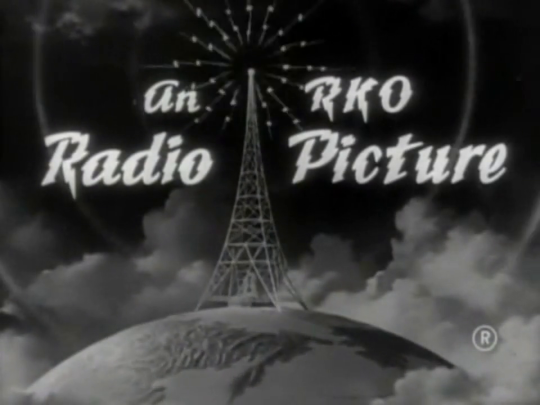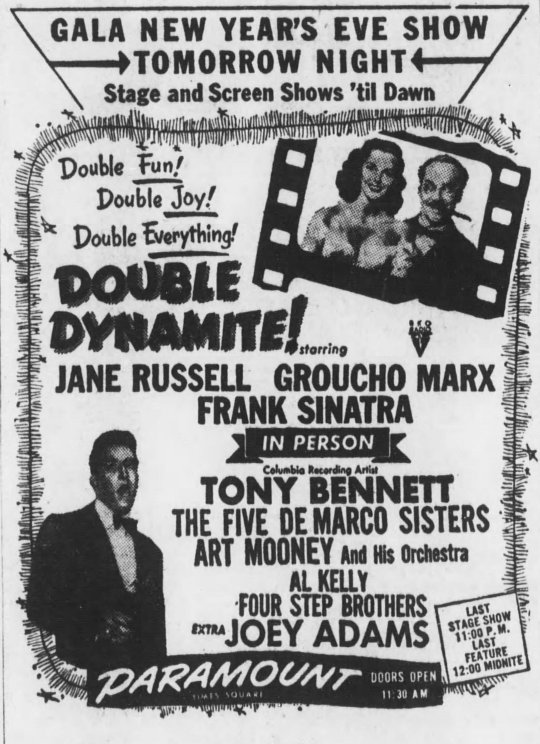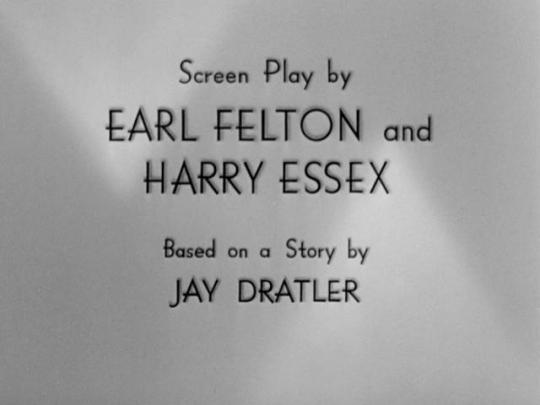RKO – 1952 Part I by Matthew Dessem
By Yasmina Tawil
A series examining the output of a single studio in a single calendar year.

PROLOGUE
For RKO Pictures, 1952 really began on March 23, 1951. That was the day U.S. Marshal Charles W. Ross went to the home of screenwriter Paul Jarrico to deliver a subpoena ordering him to appear before the House Committee on Un-American Activities. The most important events at RKO in 1952—a year in which the studio released films from Nicholas Ray, Josef von Sternberg, Howard Hawks, Fritz Lang, and Michael Powell and Emeric Pressburger—had nothing to do with cinema. Instead, studio chief Howard Hughes spent that year of the blacklist transforming RKO into a club to swing at Communists, before selling the entire company to capitalists so pure they crossed the line into organized crime. By year’s end, the studio had played an integral part in ceding Hollywood power to Washington, with consequences that would define the next decade in film. RKO’s films were almost an afterthought. And it all began with that knock on Jarrico’s door.
Paul Jarrico’s subpoena was one of a group of eight issued by the House Committee early in March 1951, which opened Congress’s second round of hearings with Hollywood. The initial hearings in 1947 had led to contempt of Congress convictions and jail time for the Hollywood Ten, the original group of screenwriters and directors who’d refused to answer questions about their membership in the Communist Party. But although right-wing publications like Red Channels had pursued the idea that Hollywood had been infiltrated by subversive agents, Congress hadn’t re-addressed the issue. Jarrico, along with several of his compatriots, managed to initially avoid the subpoena servers; the Communist Party was testing various approaches to dealing with HUAC and disappearing was one of them. But they did find Larry Parks, an actor in Jarrico’s batch of subpoenas. On March 21, in a closed-to-the-public “executive session,” Parks gave the names of other party members. Details of the closed session were immediately leaked; when the news broke, Jarrico resurfaced and issued a public statement that left no doubt where he stood on the issue of naming names:
“If I have to choose between crawling in the mud with Larry Parks or going to jail like my courageous friends of the Hollywood 10, I shall certainly choose the latter.”
“Crawling in the mud” was actually Parks’s term for his own testimony, not Jarrico’s, but it wasn’t a good year for nuance. Jarrico’s stand had long-reaching consequences for his career, and for RKO, where he’d been revising a film called The Las Vegas Story. Howard Hughes, running the studio at the time, was a hardline anti-Communist who had no patience for Jarrico’s public scorn toward informers. The day the subpoena was delivered, he had Jarrico turned away at the studio gate without so much as a chance to clean out his office.

For whatever it’s worth, Paul Jarrico was a member of the Communist Party—in fact, in the mid-1950s, he was the head of the Hollywood section. (“I presided over its liquidation,” he’d later tell Patrick McGilligan for his great oral history of the blacklist Tender Comrades.) But the idea that Communist screenwriters were working to overthrow the United States government was nonsense. Jarrico described the Party for most of the time he was a member as “the tail to the liberal-Democratic kite,” and didn’t see any contradiction between his political beliefs and his patriotism.
Jarrico faced the committee in Washington on Friday, April 13, 1951, and struck something of a conciliatory tone, at least toward RKO. Asked what he’d been working on, he replied, “…The Las Vegas Story, which is currently shooting in Hollywood. I urge you all to see it.” But the committee had learned from its mistakes in 1947, and the hearings were orchestrated to make it impossible for unfriendly witnesses to come out unruined. In Jarrico’s case, his one-time writing partner, Richard J. Collins, had been scheduled to name him as a member of the Communist Party—along with everyone else he could remember—in an open session the day before Jarrico testified.
Jarrico later chalked this up to professional jealousy: he and Collins had collaborated on Song of Russia, a pro-Soviet Union film made at MGM while the USA and USSR were World War II allies. In Jarrico’s recollection, Collins did very little of the work, and Jarrico broke up the partnership. Collins named him, Jarrico said, because “he wanted to stand on his own two knees.” But regardless of his motivations, by the time Jarrico was sworn in, there was hardly anything for him to do but react to Collins’s allegations. He showed up with a statement but the committee wouldn’t let him read it; he refused to answer any questions about his Communist Party membership on Fifth Amendment grounds (in 1947, the Hollywood Ten had refused to answer on First Amendment grounds, which left them open to contempt of Congress charges). Jarrio wasn’t entirely silent, however, and the Committee wasn’t able to control all of his testimony. When asked if he would help uncover anyone who was “subversive in their attitude toward the constitutional form of government in our Nation,” Jarrico replied that he considered the Committee on Un-American Activities to be one such subversive organization. And he had this rather remarkable exchange with Representative Clyde Doyle (D-CA), who asked if Jarrico had any suggestions for legislation to help the Committee be more effective in finding subversives. Jarrico told him he had one idea:
“You might revise your guide to subversive organizations and publications issued by this committee. It includes, for instance, the Hollywood Democratic Committee, and, without wishing to embarrass you, Congressman Doyle, perhaps you remember that that committee contributed to your campaign and wrote speeches for your campaign. It is listed here as a subversive organization.”
This moment didn’t make the newspapers—the New York Times, for example, focused on Jarrico’s refusal to talk, and ran a photo of him, arms crossed, looking petulant. But they did run part of the statement the committee wouldn’t let him read:
“I am proud of my beliefs. I am proud of my affiliations. I’ll be damned, though, if I’ll disclose them to my enemies to be used against my friends.”
It wasn’t a good season for standing on principle. Although Doyle told Jarrico, incredibly, “we are not interested in blacklisting anyone,” RKO had already fired him, and no further work was forthcoming. That left The Las Vegas Story, already in production. Hughes ordered immediate rewrites to throw out everything Jarrico had done, but writing credits, then as now, were assigned by the Screen Writers Guild (an ancestor of the Writer’s Guild of America). On September 19, 1951, after evaluating the work done by all writers, the Guild notified RKO that The Las Vegas Story’s screenplay should be credited to Earl Felton, Harry Essex, and Paul Jarrico. The collision course was set.
WINTER

Summer blockbuster season wasn’t a thing yet in 1952, but January was already a dumping ground. RKO had opened three films over Christmas, 1951, which were still making their way across the country throughout January (and, indeed, throughout the year) in those days before wide releases. In Boston, you could see On Dangerous Ground, a Nicholas Ray film starring Ida Lupino and Robert Ryan that swoons from noir to melodrama. In New York, the Little Carnegie Theater reopened after renovations with Akira Kurosawa’s Rashomon, an RKO acquisition. The rest of the country had to make do with RKO’s wider release that season: Double Dynamite, a Jane Russell vehicle whose title, the advertising made clear, meant exactly what it sounded like. Of course, you could see Double Dynamite in New York or Boston, too—at New York’s Paramount Theater, the film, which featured Frank Sinatra, was accompanied by a live performance from Tony Bennett.
But after the ball dropped in Times Square, RKO had virtually nothing new to offer. Their logo appeared on a couple of Disney shorts – the studio had a distribution deal from the not-that-long-ago days when they’d owned their own theaters – but their only new feature in January was Tembo, a staged safari travelogue by archer Howard Hill, which had already played a small Texas cinema circuit before RKO acquired it.
Production was equally dead; no films were being made on the lot that January. Two films that would ultimately be released by RKO were in production, however: Hans Christian Andersen and Sudden Fear. One was a heartwarming fictional biopic, the other a psychological noir in which aging actress Joan Crawford played an aging playwright, but they had one thing in common: neither was an RKO project. In 1952, the easiest way to make a film at RKO was not to make a film at RKO at all.
The reason was the studio’s managerial structure under Hughes, which could charitably be described as impossible. If Washington, D.C. was the sun RKO orbited that year—its gravitational pull distorting every decision—Hughes was its moon, cold and remote. Richard B. Jewell, author of a marvelous two-volume history of RKO—the second volume, Slow Fade To Black: The Decline of RKO Radio Pictures, is forthcoming from the University of California Press in March—sketched it out in an interview. Though Hughes had gained control of the studio in 1948, he was hands-off, to put it mildly. He maintained an office on the Samuel Goldwyn lot a mile away and communicated with his employees almost exclusively via memos, when he communicated at all. According to one story, probably apocryphal, he visited the studio he ran only once—late at night, when no employees were on the lot. After touring the facilities, he offered two words of feedback: “Paint it.” (Jewell reports that one former employee told him that during that period, there was a sudden influx of painters that no one had been told to expect, so perhaps it really happened.)

Whether Hughes paid that secret late night visit or never set foot on the lot at all, the effect was the same: he was a distant and capricious god. No one at RKO, regardless of their position, was allowed to contact him directly; everyone had to go through C.J. Tevlin, whom Hughes had installed on the lot after forcing out the previous management. He would take weeks to respond to simple questions, while simultaneously insisting that he alone could make final decisions. And being ignored was the best-case scenario: when Hughes took an interest in a project (or, just as often, in its lead actress), he bothered the producers incessantly with lengthy, obsessive memos micromanaging everything. Or, to be precise, certain things. Here, for example, is just part of a single memo about a single costume choice for Jane Russell in Joseph von Sternberg’s Macao, quoted in Betty Lasky’s RKO: The Biggest Little Major of Them All:
The dress is absolutely terrific and should be used, by all means. However, the fit of the dress around her breasts is not good and gives the impression, God forbid, that her breasts are padded or artificial. They just don’t appear to be in natural contour. It looks as if she is wearing a brassiere of some very stiff material which does not take to the contour of her breasts.
I am not recommending she go without a brassiere, as I know this is a very necessary piece of equipment for Russell. But I thought, if we could find a half-brassiere which will support her breasts upward and still not be noticeable under the dress, or, alternatively, a very thin brassiere made of very thin material so that the natural contour of her breasts will show through the dress, it will be a great deal more effective.
Now it would be extremely valuable if the brassiere, or the dress, incorporated some kind of a point at the nipple because I know this does not ever occur naturally in the case of Jane Russell. Her breasts always appear to be round, or flat, at that point so something artificial here would be extremely desirable if it could be incorporated without destroying the contour of the rest of her breasts.
It goes on from there. While Hughes spent his time thinking very methodically about Jane Russell’s breasts, projects languished and died waiting for a greenlight. Hughes may have had some sense his management style was less than ideal: in 1950, he had brought whiz-kid producers Jerry Wald and Norman Krasna to RKO with great fanfare to create “a studio within the studio.” Wald and Krasna were, according to the original plans, to operate on the lot with autonomy, producing twelve films a year for a five year term: sixty total. This would have been great for RKO, if it had ever happened. But as Wald and Krasna soon discovered, their contract didn’t give them greenlight power, and by 1952, two years into their five-year term, they’d only managed to drag two films through Hughes’ ringer to theaters. The studio’s dysfunction wasn’t a secret around town by this point either; agents were steering clients away. RKO managed to fill its release schedule through a mix of long-shelved projects, distribution deals like the one with Disney, acquisitions—and independent productions, like Hans Christian Andersen and Sudden Fear, where Hughes had no power to gum up the works.
But despite everything, some films did make it through. The first all-RKO production to make it to screens in 1952 was Paul Jarrico’s pre-HUAC assignment, The Las Vegas Story. It opened with a gala premiere in Las Vegas on February 12, at which Jane Russell showed up sporting a badly-concealed black eye. According to studio publicists, a gust of wind had blown a cab door in her face, although even at the time newspapers noted that her then-husband, former UCLA football star Robert Waterfield, had abruptly left town rather than attend the premiere as scheduled. Years later, Hedda Hopper would blame Russell in print for her own abuse, as not-too-subtle payback for not giving her an exclusive:
I later asked Jane why she didn’t call me and tell me the truth of the incident. “I just didn’t think of it, Hedda,” she said. “Things were in a sort of a turmoil, you know.” After the “accident” Jane went on the wagon and stayed there.

The film wasn’t any more successful than the premiere: it’s a wan Casablanca knock-off that substitutes Russell for Bergman, Victor Mature for Bogart, and Hoagy Carmichael for Dooley Wilson. The finale, a chase between car and helicopter, is genuinely thrilling, but it’s a long slog to get there. But the credits are the real showstopper: Paul Jarrico’s name is entirely missing. This put Hughes and RKO not only at odds with their one-time employee, but with the Screen Writers Guild. It was a bold move to very publicly ignore the terms of a union contract. At the very least, Paul Jarrico had obvious grounds for a lawsuit. So naturally, Howard Hughes sued him first.

